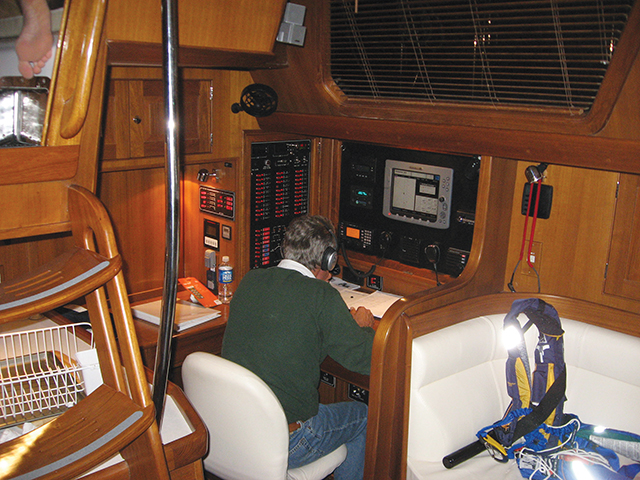With modern satellite and high frequency communication tools, you never have to be out of the loop (published February 2013)
Going to sea or taking off to some far cruising ground no longer forces you to step off the merry-go-round of civilization. For better or worse, modern communications around the world enable us—whether 1,000 miles out at sea or anchored in a foreign port—to send and receive messages and stay in regular phone contact with family and friends at home.
High seas communications are split between the very high tech world of satellite communications and the lower tech option based on high frequency radio communications. The first is fast and reliable, but can be expensive. The second is slower and less reliable, but much less expensive.
HIGH TECH RULES
Over the last decade, as technology has been developed and improved, satellite communication has swept through the cruising fleets. At the highest end of the spectrum, INMARSAT provides a bulletproof satellite service that is robust enough for the world’s shipping and tanker fleets. Most megayachts carry INMARSAT-compatible domes with directional antennas that can lock onto satellites as they upload and download voice and digital data.
The speed at which data can be received and transferred is getting better and better, but it is not yet up to the kinds of speeds we expect from high-speed Internet ashore.
Companies such as Sailor and KVH build a range of units that may be suitable and range in price from around $5,000 to much more. The broadband capability allows between 2 and 4 megabits (not megabytes) per second with an associated cost of about $1.50 per minute. Obviously, emailing extensively, uploading photos and going online will drive up the usage costs rapidly.
For those on a more modest budget, Iridium sat phones have become popular amongst the cruising fleet. Iridium has worldwide coverage, with the exception of some regions of the southern Pacific Ocean and Antarctica. The beauty of an Iridium phone is that you can buy airtime by the minute, in advance, and then use as much or as little as you like. A new sat phone will run about $1,000, with some additional expense for a marine installation and antenna. Then, you will find that minutes cost $1.20 each or less if you buy in bulk.
With an Iridium phone, you can make regular phone calls, send text messages, connect to an Internet email server, and call the nearest search and rescue service. They are portable and have rechargeable batteries, so you can take one with you into a liferaft if the worst happens.
To keep the use of valuable minutes down to a minimum, it is helpful to work with email providers like OCENS or UUNet. These companies will deliver email, GRIB files and even images in condensed packets of data that come across the airwaves much more quickly than raw data. OCENS provides a full suite of software tools for handling email, weather maps, weather forecasts, oceanographic data and even personalized ocean routing with professionals like Chris Parker.
In addition, there are weather forecasters who will deliver personalized weather and routing via short, easily delivered emails. Chris Parker works primarily in the North Atlantic, Bahamas and Caribbean. Commanders’ Weather is a full-fledged commercial ocean routing company that supplies its clients with daily emails. An Iridium phone is a great way to get daily weather at sea.
The invention of the SPOT Satellite GPS Messenger opened the door to a new, low-cost way for sailors to communicate via satellite with folks at home and rescue services. The basic SPOT allows you to send an “I’m okay” message and your GPS position to 10 pre-programmed contacts. But SPOT does not receive messages.
To advance the pocket-sized satellite communication function, SPOT created the SPOT Connect, which is a satellite transceiver that interfaces with your smartphone via Bluetooth and allows you to send and receive short, 120 character messages—sort of like Tweeting. A SPOT Messenger costs only $99.99 and has a $99 annual fee. A SPOT Connect costs $149.99 and has a $99.99 annual fee.
The new DeLorme InReach Smartphone Satellite Messenger transforms your smartphone or tablet into a worldwide, two-way texting device. Your phone or tablet interfaces with the InReach transceiver, which is small enough to fit into your pocket, and then communicates with the Iridium satellite network. The unit has a full S.O.S. function and allows you to send texts of up to 140 characters; you can use it to update Facebook and Twitter. A DeLorme InReach costs $249.95 and has an annual subscription.
Last but certainly not least in the Satellite communications category is the Emergency Position Indicating Beacon (EPIRB). A dedicated distress signaling devices, an EPIRB broadcasts distress signals on both satellite compatible frequencies and VHF frequencies. The units can be manually operated or water-activated. Modern units have a built-in GPS, so your exact position is broadcast to the rescue services with the distress signal. EPIRBs have saved hundreds of lives and reduce rescue times from days to several hours.
HIGH FREQUENCY COMMS
 High frequency transceivers and their amateur radio cousins have been the workhorses of high seas communications for the last 100 years. The modern single sideband (SSB) is a wonderful radio with true long distance broadcast and receive capabilities and, with modern computers and software, the ability to keep you in touch via email from anywhere in the world.
High frequency transceivers and their amateur radio cousins have been the workhorses of high seas communications for the last 100 years. The modern single sideband (SSB) is a wonderful radio with true long distance broadcast and receive capabilities and, with modern computers and software, the ability to keep you in touch via email from anywhere in the world.
The voice function on SSB and ham allows you to join networks as you sail from place to place and to speak with weather gurus and routers who maintain SSB broadcasts. Chris Parker in Florida and Herb Hilgenberg in Canada are two of the best known weather professionals who maintain regular SSB broadcasts for their clients and friends.
There are government-run broadcasts offered by maritime nations around the world that can also help you collect your weather information. And an SSB will allow you to download the universal time signal so you can set your watches accurately when taking celestial sights.
High Seas radio used to be serviced by AT&T, which would patch your radio call through to the land line telephone system for placing ship to shore calls. AT&T shut down this service in 1999 with the advent of satellite telephones. Today, only WLO offers a full service ship-to-shore service for HF radio users on the high seas. Based on the Gulf Coast of the U.S., WLO serves the Atlantic, Caribbean, Gulf of Mexico and western Pacific Ocean.
With a modem and a laptop computer, you can use an SSB or ham radio to download NOAA or other weather maps, NOAA GRIB files and Navtex reports. For years, this was the next best way to get weather after an Iridium phone. But Stan Honey and Jim Corenman, genius computer guys who are also great sailors, changed all that. Honey created SailMail as a not-for-profit organization that would allow cruisers to connect to a shore-based e-mail server by HF radio. Honey wrote the first e-mail integration software, built the first tower in California, and hooked the first server to the Internet. Jim Corenman created the software known as AirMail that is the protocol for SailMail users and is also used by ham operators who work through the international ham networks with a system named Winlink.
These systems require a high seas transceiver, a Pactor modem and a computer. An SSB or ham radio installed properly on a boat with a ground, tuner and antenna will cost between $1,500 and $2,000. A Pactor-4 modem runs $1,200 for the standard model and almost $1,500 for the new high speed model. And a laptop computer can cost anywhere from $400 to $1200.
The way Honey and Corenman have designed the Airmail software and hardware interface for SailMail and Winlink makes operating the system very user friendly. Once you have set up the system, all you have to do is click the send and receive button on the email program and the software will turn on your radio, tune it to the clearest shore station and access your email account.
By adding ShadowMail to your SailMail account, you can access other email accounts at Gmail, Yahoo or elsewhere and then download only the emails you want while leaving unwanted spam on the server to be opened or deleted later when you have a fast Wi-Fi connection. This enables you to keep your SailMail e-mail address private and not exposed to spam.
If there is a downside to HF communications, it has be propagation. There are times when solar activity and atmospherics make it very hard to find a clear frequency on which to broadcast and receive. Often it is hard to transmit toward the sun in the morning and in the afternoon. Midday can be even worse. The best times of day are early morning and evening.
With that in mind, some offshore sailors and cruisers choose to carry an Iridium phone as a back-up or vice versa; SailMail was written to accept input from various sources, so you can still access your email accounts with SailMail via an Iridium phone when the HF radio is having propagation problems.
STAYING CONNECTED
 It is amazing how many ports of the world are served by commercial or noncommercial Wi-Fi providers. And, there are thousands of free hotspots to be found around North America and the world. Using the hotspot function on smartphones opens you up to Wi-Fi via cellular networks with a broader range than you get from local Wi-Fi providers. So, when you are along a coast and hanging out in anchorages, you will find that the cruising boats with the Wi-Fi antennas on their rigs are clustered together in the best free Wi-Fi locations.
It is amazing how many ports of the world are served by commercial or noncommercial Wi-Fi providers. And, there are thousands of free hotspots to be found around North America and the world. Using the hotspot function on smartphones opens you up to Wi-Fi via cellular networks with a broader range than you get from local Wi-Fi providers. So, when you are along a coast and hanging out in anchorages, you will find that the cruising boats with the Wi-Fi antennas on their rigs are clustered together in the best free Wi-Fi locations.
But to break the shoreline bonds and head out to parts unknown, it only makes sense to have good high seas communication systems aboard both for social and safety reasons. Redundancy is the key—make sure you design your communication systems to give you options when one avenue is not working so you can stay connected whenever you need to be. Satellite technology is getting faster and faster and costs are not escalating too badly. But don’t overlook the benefits of HF technology and the usefulness of SailMail. If you can afford to go with both systems, it makes sense to do so.















